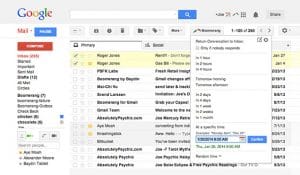Business Insider is an excellent target for guest posts, if your site is in the kind of industry they’ll be willing to publish. According to Alexa rankings, they’re #100 in the United States and #326 worldwide. That’s a lot of power and a lot of visibility.
You might be surprised to learn that it’s actually relatively straight-forward to become a contributor to Business Insider. They aren’t as picky as many other high profile sites, and you have several possible options to get in.
What Business Insider Wants
You should, of course, understand the types of content and guidelines that Business Insider puts forth for their contributors. On their contribution page, they say this:
- “Most of our contributors are experts on one or more of the subjects we cover. They include professors, investors, venture capitalists, entrepreneurs, executives, attorneys, consultants, authors, professional service providers, journalists, technologists, and engineers. Our contributors provide thoughtful commentary on a range of topics. It’s recommended that you spend time reading through the site to get an idea of the type of stories we publish.”
As of this writing, their front page has a bunch of political articles, an article about the stock market, an article about the ongoing Uber scandals, an article about Facebook’s head of HR talking about job interview questions, an article about marijuana, and an article on color blindness.
If you look up in their top bar for their categories, you see a lot more than just trending American politics. They have categories for careers, education, finance, graphics, law, media, retail, science, sports, tech, travel, and a dozen or two more.
What are they looking for? In the contributor FAQ, they say this:
- “Engaging and thoughtful analysis, opinion, inside scoops or expert advice. We’re all over breaking news, so don’t worry about covering that. The single best piece of advice? Read the site. Get a feel for the types of stories we run. Don’t pitch stories we’ve already written. Be creative.”
Essentially, they want to cover news and breaking information themselves, and leave the critical analysis and outside perspectives to contributors. Covering some new development in politics won’t get you published, but a deep, insightful article about how the new healthcare plan will affect healthcare IT very well might.
The key is to leverage your own unique perspective. Bring something to the table that you get from blogging about your subject, from running a business in your industry, or just from your personal experience. They want content that has unique commentary and opinions. They want insider information you can’t find anywhere else online. They want business, finance, and economics topics. Also, whenever possible, they want primary reporting. Don’t quote someone else quoting someone else, quote people directly.
One are where Business Insider differs from many websites is in terms of word count. I, and many other marketers, will tell you that any blog post under 1,000 words is probably too short to be valuable. For most blog SEO, this is true, and it’s why I always aim for closer to 2,000 for my posts. However, Business Insider is a sort of “lunch break” news site. The people who read their content are busy and don’t have more than a few minutes at a time to read stories. They’ll browse headlines, find something interesting, and spend a minute or two reading it. Long posts don’t have a place on their site.
To this end, they say that posts ranging from 500 to 800 words do well. This isn’t a fixed rule – and in fact you’ll find longer posts in some of their more detailed sections, like Tech Insider – but as a first-time contributor you probably want to aim for something around 600-700. Don’t try to be exceptional until you’ve proven that you can stand out.
What Will Get You Rejected
On the same contributor FAQ, Business Insider lists some topics to avoid.
I’ve reproduced it here, but you can check the link above to see if it’s changed since I published this.
- News coverage. Business Insider staff writers pretty much do nothing other than cover news stories day in and day out. If you want to write something about politics, or some new video game release, or any other cursory news, they aren’t going to accept it. However, this does leave room for niche, industry news that otherwise wouldn’t be covered.
- General information. They specifically call out numbered lists, how to articles, tips and tricks posts and the like. The key here is not the format, though, it’s the content. They don’t want generic, published-everywhere content.
- Sponsored posts. If you’re writing on behalf of someone else, shilling a product or service, they aren’t going to publish it. They’ll only publish a sponsored post if they’re the ones getting the money for it.
- Excessively personal information. A few personal anecdotes that support a point can be good. Going into detail about your own personal diet and how you’ve used it to lose weight is probably too personal for them.
- Excessive jargon. If your post is more acronyms than it is content, give it a pass.
- Attacks. They won’t publish anything that seems comprised of a personal attack on someone else, a conspiracy theory, defamation, or foul language.
- Infringement. Obviously, anything that steals content, tries to publish trade secrets, or violates trademarks is against the law and thus won’t be published.
- Keyword marketing. If it’s transparent that your post is simply there to associate your brand with a keyword on a high profile site, they’ll reject it.
The last point is the one that gets so many guest posters these days. Yes, we all know you’re contributing so you can get a link and association to the topic at hand. That doesn’t mean you can just ignore value, however. The post quality comes first, the link is an afterthought.
Syndication
If you read the Business Insider contributor FAQ, one thing you might notice is one little line. “We don’t pay freelancers, but we’re willing to republish blog posts or articles that you retain the rights to.” What this little line means is that they’ll syndicate content from your site, without claiming rights to it.
Now, the chances that they’ll syndicate something from your site are pretty slim. They want to syndicate content from high profile sites, like Inc. They also use syndication as a sort of soft payment since they don’t actually pay contributors who aren’t staff writers. Since I’m working from the assumption that you haven’t contributed to Business Insider before, you’re not going to be syndicated directly.
What you might be able to do, however, is contribute to another site that is syndicated with Business Insider. Keep an eye on the post you write and see if it appears on Business Insider. If it does, you can then send a message to the editor of that section and tell them that, hey, they syndicated a piece of your content, and you’d like to write for them as well.
This is a pretty long shot, so you can leverage this syndication in another way. Simply skip the part about waiting for a post you wrote to be syndicated. Think of it this way; site A publishes your content, and site BI publishes content from site A. You’ve written for site A, so your content obviously meets the standards that site BI publishes, so you should be able to get in. Simply include the fact that you’ve written for site A when you pitch something.
Official Submissions
The generally accepted way of getting a post published on Business Insider is to use their official contribution method. This is a multi-step process, but it’s not as bad as it sounds.
The first step is to spend a little while reading the site. You really want to get the perspective, the bias, and the topics down. I can’t give you topic ideas – I’d be saving them for myself anyways – but I can guide you in the right direction. All of those FAQ points up above are a good place to start. Within your industry, find something you have a unique perspective on, that ties in with current events but is not itself a piece of news. It’s going to take a few tries to get right, so don’t stress too much over it; your first few attempts are likely to be rejected.
Next, you need to make a minor portfolio. This portfolio should include a brief bio of yourself, a proposed headline for your piece, and links to anything noteworthy you’ve published before.
- For bio, you want something 2-3 sentences long that describes who you are, what you do, and how to contact you. Something like “Davis Davidson is a writer, marketer, and influencer in the world of sports. He contributes to SportsCenter, The Huffington Post, and CNN. You can contact him at <website link> or via Twitter @username.” Anything more than that will be trimmed out or they will ask you to revise it to be shorter.
- For headline, write something catchy, the same way you would write any other headline. However, make sure you don’t explicitly mention or call out the headline in your piece, because Business Insider will often change your headline. It’s not a guarantee that they will, but neither is it guaranteed to slide in unchanged.
- For links, aim for 3-5 contributions to high profile publications and one from your own website, preferably a relevant piece of content they might consider syndicating or linking to later. The idea is to showcase that you’ve posted on other relevant sites as well, and that you’re not just some nobody coming in off the street. This is where you include links – and a mention – form sites Business Insider syndicates, if you’ve been published by any of them.
In addition to all of this, you need the final draft of your post for submission. There’s no “pitch an idea and we’ll get back to you” process with Business Insider. There are two reasons for this. The first is that they have hundreds of contributors and thousands of submissions to comb through pretty much at all times. If anyone tried to go through a multi-step process like that, it would eat up the time of the editors, and that’s a hassle they don’t want to deal with. The second reason is that the topics they cover are changing frequently enough that if they can’t publish right away, the article might be old news or might no longer be accurate by the time they get it published.
Once you have all of this down, you can send it all in an email to their submissions hotline, which is contributors (at) businessinisder.com. They will send you back a form letter – or nothing at all – if you’re rejected. However, if the editor thinks you have promise, they might send something a little more personalized, or they might accept it. Either way, rest and repeat until you’re in.
Contacting Contributors
The third option for getting published on Business Insider is to stalk some of the existing contributors. Look in your niche and look for authors who submit guest content. Send them a message and ask them if they can set you up with a contact within Business Insider, some more personalized email address for example. You can also check the accounts of the editors to see if they have contact information, though most of them have scrubbed this out to avoid specifically this scenario.
Not sure who else writes for the site? You can see a complete list of their authors here. It’s sorted by name, not by vertical, and it includes agencies and sites they syndicate, so it can be a great resource for finding connections.
 ContentPowered.com
ContentPowered.com







